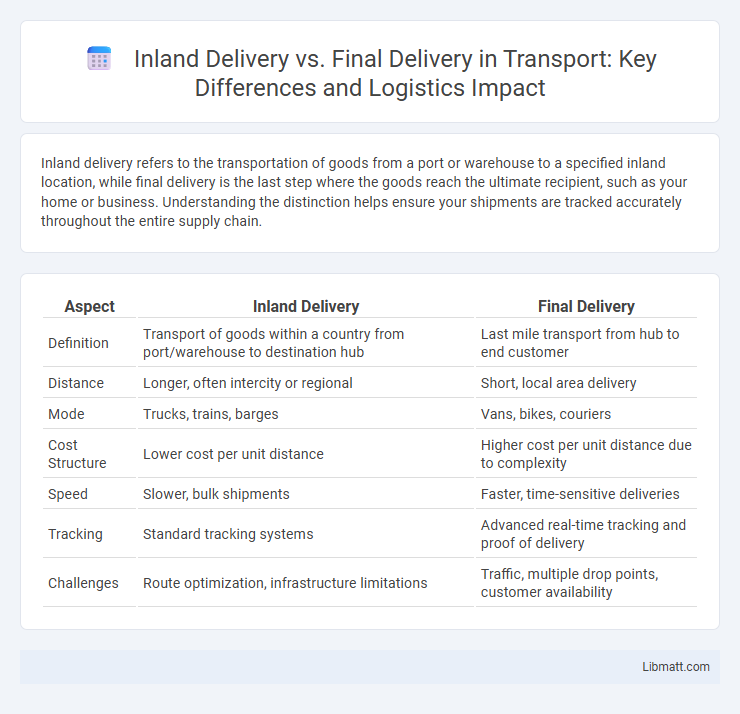Inland delivery refers to the transportation of goods from a port or warehouse to a specified inland location, while final delivery is the last step where the goods reach the ultimate recipient, such as your home or business. Understanding the distinction helps ensure your shipments are tracked accurately throughout the entire supply chain.
Table of Comparison
| Aspect | Inland Delivery | Final Delivery |
|---|---|---|
| Definition | Transport of goods within a country from port/warehouse to destination hub | Last mile transport from hub to end customer |
| Distance | Longer, often intercity or regional | Short, local area delivery |
| Mode | Trucks, trains, barges | Vans, bikes, couriers |
| Cost Structure | Lower cost per unit distance | Higher cost per unit distance due to complexity |
| Speed | Slower, bulk shipments | Faster, time-sensitive deliveries |
| Tracking | Standard tracking systems | Advanced real-time tracking and proof of delivery |
| Challenges | Route optimization, infrastructure limitations | Traffic, multiple drop points, customer availability |
Introduction to Inland Delivery vs Final Delivery
Inland delivery refers to the transportation of goods from a port or warehouse to an inland destination within the same country. Final delivery, however, denotes the last leg of the supply chain where goods are delivered directly to the end customer or retail location. Understanding the distinction between inland delivery and final delivery is crucial for optimizing logistics, controlling costs, and ensuring timely order fulfillment.
Defining Inland Delivery
Inland delivery refers to the transportation of goods from a port or airport to an inland destination within the same country, often involving trucks or trains. It differs from final delivery, which is the last leg of the shipping process where the shipment reaches the end customer or recipient. Understanding inland delivery helps you optimize logistics by managing costs, transit times, and handling requirements effectively.
Understanding Final Delivery
Final delivery refers to the last step in the shipping process, where goods are transported from a local distribution center to your specified destination, such as a home or business. Unlike inland delivery, which involves transporting shipments overland between major hubs or warehouses, final delivery ensures the package reaches the end recipient directly. Understanding final delivery is crucial for tracking the completion of your shipment and managing customer expectations effectively.
Key Differences Between Inland and Final Delivery
Inland delivery refers to the transportation of goods within a country from a port or entry point to the consignee's location, while final delivery involves handing over the goods to the end recipient, completing the supply chain process. Inland delivery often includes multiple modes of transport such as trucking or rail, whereas final delivery emphasizes last-mile logistics to ensure timely receipt. Key differences involve scope, distance covered, and the role in the overall supply chain, with inland delivery focusing on domestic transit and final delivery closing the distribution loop.
Transportation Modes in Inland Delivery
Inland delivery primarily utilizes transportation modes such as trucks, railways, and barges to move goods from ports or warehouses to their final destination within a country. Trucks offer flexible and fast door-to-door service, while railways provide cost-effective solutions for heavy or bulk shipments over long distances. Understanding these transportation modes in inland delivery helps optimize your supply chain by balancing speed, cost, and cargo type.
Logistics and Coordination in Final Delivery
Final delivery requires precise logistics and coordination to ensure timely arrival at the recipient's location, involving last-mile transportation, route optimization, and real-time tracking systems. Inland delivery covers the movement of goods from shipping hubs to regional distribution centers, while final delivery focuses on the efficient handover to the end customer, often requiring collaboration with local carriers and adherence to specific delivery windows. Your ability to coordinate these steps effectively can significantly enhance customer satisfaction and reduce operational costs.
Cost Comparison: Inland vs Final Delivery
Inland delivery costs generally remain lower than final delivery expenses due to shorter transportation distances and fewer handling requirements. Final delivery often incurs higher fees because it includes last-mile logistics, which involve navigating urban congestion and multiple drop-offs. Understanding these cost differences helps You optimize your shipping budget by selecting the most cost-effective delivery stage based on your supply chain needs.
Impact on Delivery Timelines
Inland delivery significantly reduces overall shipping time by enabling faster transit from port to destination through local carriers and optimized logistics routes. Final delivery, which involves last-mile transportation directly to the recipient, can introduce delays due to urban traffic, address verification, and parcel handling complexities. Efficient coordination between inland and final delivery stages is crucial to minimizing delays and ensuring timely shipment arrival.
Challenges and Solutions in Both Delivery Types
Inland delivery faces challenges such as transportation delays, limited infrastructure, and coordination across multiple carriers, requiring advanced tracking systems and real-time communication platforms to ensure timely shipments. Final delivery encounters obstacles like last-mile congestion, address inaccuracies, and customer availability, best addressed through flexible delivery windows, route optimization, and enhanced proof-of-delivery technologies. Both delivery types benefit from integrated logistics solutions, data analytics, and collaborative partnerships to improve efficiency and reduce costs.
Choosing the Right Delivery Option for Your Business
Inland delivery and final delivery serve distinct roles in the supply chain, with inland delivery focusing on transporting goods from a port or warehouse to a regional distribution center, while final delivery completes the journey by bringing products directly to the end customer. Choosing the right delivery option depends on your business's distribution network, customer location, and urgency of shipment. Optimizing your delivery strategy can reduce costs, improve customer satisfaction, and increase overall operational efficiency.
inland delivery vs final delivery Infographic

 libmatt.com
libmatt.com